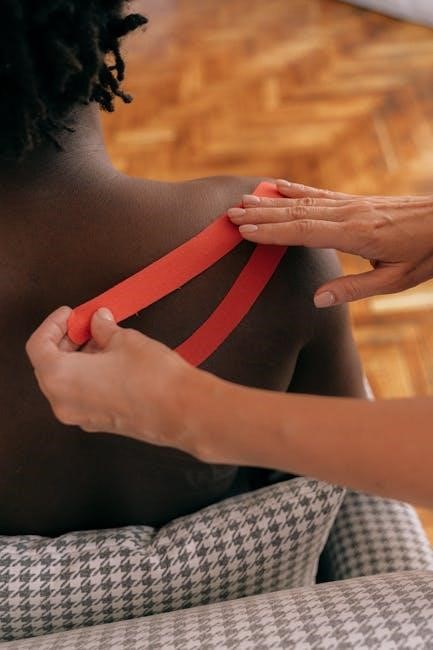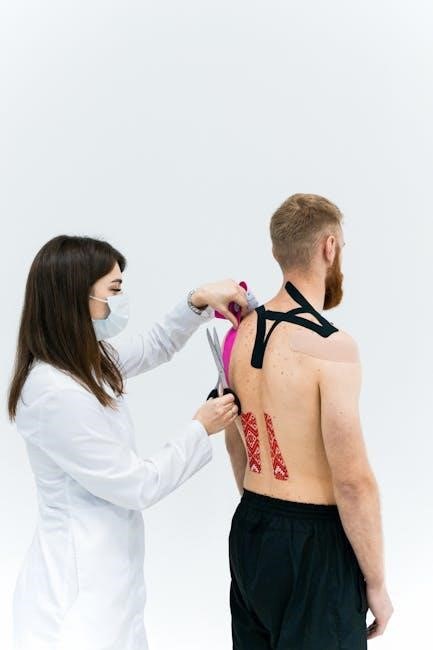kinesiology taping guide

Kinesiology taping is a non-invasive therapeutic technique using elastic tape to support muscles, joints, and skin. Mimicking skin elasticity, it promotes healing, reduces pain, and enhances mobility. Popular in sports and physical therapy, its benefits are backed by scientific research, offering a versatile solution for various musculoskeletal conditions.
What is Kinesiology Taping?
Kinesiology taping is a non-invasive therapeutic method using elastic tape to support muscles, joints, and skin. The tape, typically latex-free and water-resistant, is designed to mimic the elasticity of human skin. It is applied directly to the skin to reduce pain, inflammation, and swelling while promoting healing. Unlike traditional rigid tapes, kinesiology tape allows for a full range of motion, making it ideal for active individuals. It works by lifting the skin to improve blood and lymphatic circulation, which can accelerate recovery. Commonly used in sports, physical therapy, and rehabilitation, kinesiology taping is a versatile tool for addressing musculoskeletal issues and enhancing performance.
History and Development
Kinesiology taping, also known as kinesio taping, was developed in the 1970s by Dr. Kenzo Kase, a Japanese chiropractor. Kase sought to create a more flexible alternative to rigid athletic tapes, aiming to support joints and muscles without restricting movement. The term “kinesiology” refers to the study of human movement, reflecting the tape’s purpose of enhancing motion while providing therapeutic benefits. Initially popular in Japan, kinesiology taping gained global recognition in the 1980s and 1990s, particularly among physical therapists and athletes. Its widespread use became prominent after the 2008 Beijing Olympics, where athletes were seen wearing colorful strips of tape. Since then, it has evolved into a widely accepted tool in sports medicine and rehabilitation, with ongoing research supporting its effectiveness.
Benefits of Kinesiology Taping
Kinesiology taping offers pain relief, reduces inflammation, enhances muscle support, and improves joint stability. It promotes blood flow, reduces swelling, and supports athletic performance, aiding recovery and injury prevention.

Pain Relief and Inflammation Reduction
Kinesiology taping provides effective pain relief by lifting the skin, reducing pressure on pain receptors. This technique also decreases inflammation by improving lymphatic drainage, which helps remove excess fluids and toxins. The elastic properties of the tape allow for gentle, consistent support, enhancing blood flow and promoting healing. It is particularly beneficial for acute injuries and chronic conditions, offering a drug-free alternative to manage discomfort. Studies suggest that kinesiology taping can significantly reduce muscle soreness and joint pain, making it a popular choice among athletes and individuals undergoing physical therapy. Its non-invasive nature ensures minimal side effects, making it suitable for long-term use.
Performance Enhancement and Injury Prevention
Kinesiology taping enhances athletic performance by improving joint stability and muscle activation. The tape’s elastic properties provide dynamic support, allowing for a full range of motion while reducing muscle fatigue. It helps prevent injuries by stabilizing vulnerable areas, such as knees, shoulders, and ankles, during high-intensity activities. Additionally, the tape promotes proprioception, improving body awareness and coordination, which can lead to better technique and reduced risk of overuse injuries. Many athletes find it beneficial for maintaining peak performance without compromising mobility. While some studies debate its direct impact on strength, the tape’s ability to reduce muscle strain makes it a popular choice for injury prevention in sports and physical activities. Its lightweight, breathable design ensures comfort during prolonged use.

Types of Kinesiology Tape
Kinesiology tape includes Kinesio Tex Tape, known for its elasticity and breathability, and CureTape, which is water-resistant. Both types provide support and promote healing for muscles and joints.
Kinesio Tex Tape Characteristics
Kinesio Tex Tape is designed with elastic properties to mimic human skin, offering a full range of motion. Its breathable, latex-free material ensures comfort and reduces irritation. The tape is water-resistant, allowing extended wear during activities like swimming or showering. It adheres gently yet firmly, providing support without restricting movement. Available in various widths and lengths, it suits different body areas. Its hypoallergenic properties make it suitable for sensitive skin. The tape lifts the skin to reduce swelling and promote blood flow, enhancing recovery. These features make Kinesio Tex Tape a preferred choice for both athletes and physical therapists seeking effective, non-invasive support.
CureTape and Water-Resistant Options
CureTape stands out as a premium water-resistant kinesiology tape, designed for durability in wet conditions. Its advanced adhesive ensures it stays in place during swimming, sweating, or bathing. Unlike standard tapes, CureTape maintains its grip underwater, making it ideal for aquatic sports or prolonged use. The water-resistant properties prevent the tape from peeling or losing effectiveness, ensuring consistent support and therapeutic benefits. This feature is particularly beneficial for athletes and individuals with active lifestyles. CureTape combines strength and flexibility, offering reliable performance in various environments. Its durability and water resistance make it a top choice for those requiring long-lasting support without compromising on comfort or effectiveness.

Application Methods
Proper kinesiology taping involves clean, dry skin and precise techniques. Apply the tape with minimal stretch for support or gentle tension for therapeutic effects, aligning with muscle fibers for optimal results.
Skin Preparation and Hair Considerations
Proper skin preparation is essential for effective kinesiology taping. Clean the skin thoroughly with soap and water to remove oils, lotions, or sweat, ensuring better tape adhesion. For hairy areas, trim excess hair to prevent irritation and improve tape contact. Shaving is not recommended, as it can cause skin abrasions. If the skin is sensitive, hypoallergenic tapes are a better option. Additionally, avoid applying tape over open wounds, cuts, or sunburned areas. For individuals with sensitive skin, pre-tape adhesive sprays or hypoallergenic preparations can enhance comfort. Proper preparation ensures the tape adheres well, maximizing its therapeutic benefits and minimizing discomfort or skin reactions during and after use.
Step-by-Step Taping Techniques
When applying kinesiology tape, begin by placing the tape with the paper backing still attached, then gradually remove the backing as you smooth the tape onto the skin. Gently stretch the tape to cover the entire area you’re targeting, ensuring not to stretch it over joints, as this can cause discomfort or restrict movement. Use anchor points at both ends of the tape to secure it in place firmly. It’s important to avoid wrapping the tape too tightly, as this can impede blood flow and lead to discomfort. Additionally, do not leave the tape on for more than five days to prevent skin irritation or other adverse reactions. By following these step-by-step techniques, you can ensure the tape is applied effectively, providing the necessary support and promoting healing without causing unnecessary discomfort.
Common Applications
Kinesiology taping is widely used in sports and physical therapy to support injured areas, reduce pain, and improve mobility. It is commonly applied to knees, shoulders, and backs for injury prevention and rehabilitation support.
Use in Sports and Athletics
Kinesiology taping is widely embraced in sports for its ability to provide dynamic support during physical activity. Athletes apply it to areas like knees, shoulders, and backs to prevent injuries and enhance performance. The tape’s elasticity mimics skin, allowing for a full range of motion while offering stability to muscles and joints. It is particularly popular among runners, footballers, and tennis players who benefit from reduced muscle fatigue and improved circulation. Additionally, water-resistant options like CureTape enable athletes to continue training through sweat and water exposure without compromising the tape’s adhesive properties. This makes it an ideal choice for swimmers and those engaged in high-intensity workouts.
Role in Physical Therapy
Kinesiology taping plays a significant role in physical therapy by aiding in pain management, reducing inflammation, and improving mobility. Physical therapists use it to support injured or weakened muscles, promoting proper movement patterns. The tape helps redistribute stress, alleviating pressure on painful areas. It also enhances lymphatic drainage, which can reduce swelling and accelerate recovery. Additionally, it is used for muscle re-education, helping patients regain strength and function after injuries. The non-invasive nature of kinesiology taping makes it a valuable tool for post-surgical rehabilitation and chronic pain management. By customizing the tape’s application, therapists can address specific patient needs, ensuring a personalized approach to recovery and restoring optimal physical function.

Safety and Precautions
Proper application and removal are crucial to avoid skin irritation or allergic reactions. Avoid using kinesiology tape on broken or sensitive skin, and discontinue use if discomfort occurs.
Possible Side Effects and Contraindications
Possible Side Effects and Contraindications
Possible side effects of kinesiology taping include skin irritation, allergic reactions, or rashes due to the adhesive. It should be avoided on open wounds or sensitive areas. Contraindications include severe skin conditions like eczema or psoriasis. Proper application and removal techniques are essential to minimize risks. If any discomfort occurs, discontinue use immediately. Consulting a healthcare professional before applying the tape is recommended, especially for individuals with specific medical conditions or compromised skin integrity.
Safe Removal Practices
Safe removal of kinesiology tape is crucial to avoid skin irritation or discomfort. Begin by gently peeling the tape from one edge, working slowly and evenly. Avoid pulling the tape off quickly or yanking it, as this can cause skin irritation or even remove hair. For sensitive skin, applying a small amount of oil or lotion to the area before removal can help soften the adhesive. Remove the tape in the direction of hair growth to minimize discomfort. After removal, clean the skin with soap and water to remove any residual adhesive. If any irritation occurs, discontinue use and consult a healthcare professional. Proper removal ensures the skin remains healthy and minimizes potential side effects.
Leave a Reply
You must be logged in to post a comment.